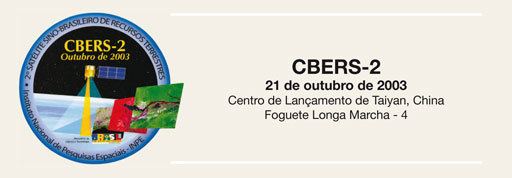Operator CNSA / INPE SATCAT no. 28057 Bus Phoenix-Eye 1 Rocket Long March 4B | COSPAR ID 2003-049A Mission duration 2 years Launch date 21 October 2003 Mission type Remote sensing | |
 | ||
Launch mass 1,450 kilograms (3,200 lb) Similar China–Brazil Earth Resource, CBERS‑1, CBERS‑4, Satélite de Coleta de Dados, Landsat 5 | ||
China–Brazil Earth Resources Satellite 2 (CBERS-2), also known as Ziyuan I-02 or Ziyuan 1B, was a remote sensing satellite operated as part of the China–Brazil Earth Resources Satellite programme between the China Centre for Resources Satellite Data and Application and Brazil's National Institute for Space Research. The second CBERS satellite to fly, it was launched by China in 2003 to replace CBERS-1.
CBERS-2 was a 1,450-kilogram (3,200 lb) spacecraft built by the China Academy of Space Technology and based on the Phoenix-Eye 1 satellite bus. The spacecraft was powered by a single solar array, which provided 1,100 watts of electricity for the satellite's systems. The instrument suite aboard the CBERS-2 spacecraft consisted of three systems: the Wide Field Imager (WFI) produced visible-light to near-infrared images with a resolution of 260 metres (850 ft) and a swath width of 890 kilometres (550 mi); a high-resolution CCD camera was used for multispectral imaging at a resolution of 20 metres (66 ft) with a swath width of 113 kilometres (70 mi); the third instrument, the Infrared Multispectral Scanner (IMS), had a resolution of 80 metres (260 ft) and a swath width of 120 kilometres (75 mi).
A Chang Zheng 4B carrier rocket, operated by the China Academy of Launch Vehicle Technology, was used to launch CBERS-2. The launch took place at 03:16 UTC on 21 October 2003, using Launch Complex 7 at the Taiyuan Satellite Launch Centre. The satellite was successfully placed into a sun-synchronous orbit.
Following the launch of CBERS-2B in 2007, CBERS-2 was retired from service. As of 1 December 2013, the dericict satellite remains in orbit, with a perigee of 780 kilometres (480 mi), an apogee of 782 kilometres (486 mi), 98.17 degrees inclination and a period of 100.33 minutes. Its orbit has a semimajor axis of 7,152.64 kilometres (4,444.44 mi), and eccentricity of 0.0001886.
